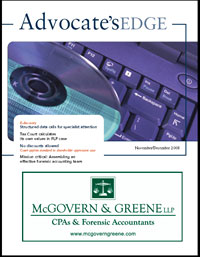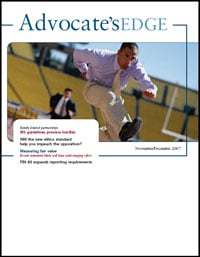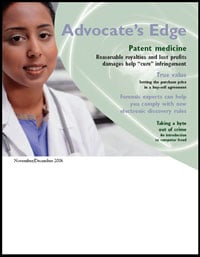Advocate’s Edge

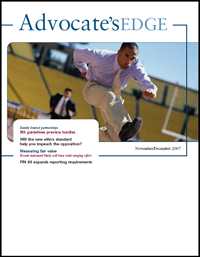 NOV/DEC 2007 ISSUE OF ADVOCATE’S EDGE
NOV/DEC 2007 ISSUE OF ADVOCATE’S EDGE
Family limited partnerships
IRS guidelines preview hurdles
Appeals Settlement Guidelines for Family Limited Partnerships and Family Limited Liability Corporations, issued by the IRS in the fall of 2006, can provide a preview of the hurdles FLPs might face when challenged. This article lists the positions the IRS is likely to take on various issues, including whether the fair market value (FMV) of transfers of FLP interests by death or gift is properly discounted and whether the FMV of the transferred property at the date of death should be included in the gross estate. Taxpayers are urged to comply with applicable IRS provisions and the FLP operating agreement.
Will the new ethics standard help you impeach the opposition?
A new ethics standard issued by the American Institute for Certified Public Accountants seeks to preserve the independence of CPAs, but it also may prevent accountants from providing expert witness testimony and forensic services in some situations. This article talks about how attorneys might be able to use the standard to undermine the credibility of the opposing parties’ witnesses.
Measuring fair value
Recent statement likely will have wide-ranging effect
A recent Financial Accounting Standards Board (FASB) statement, No. 157, Fair Value Measurements, is likely to affect every company’s financial reporting. As this article discusses, the statement defines and establishes a framework for measuring fair value and becomes effective for financial statements for fiscal years beginning after Nov. 15, 2007. Among other things, FASB 157 retains the “exchange price” notion used in previous definitions of fair value, but clarifies the concept. It also clarifies the meaning of “market participant assumptions.”
FIN 48 expands reporting requirements
Initially released in June 2006, Financial Accounting Standards Board (FASB) Interpretation 48 (FIN 48), Accounting for Uncertainty in Income Taxes, significantly revised the requirements for measuring and disclosing uncertain tax positions. FIN 48 requires both public and private companies to examine their uncertain tax positions and disclose any related potential tax liabilities on their financial statements. This article lists required disclosures and explains that failure to comply could result in charges of fraud by those who rely on the financial statements to their detriment — including regulators and shareholders.
 SEP/OCT 2007 Issue of Advocate’s Edge
SEP/OCT 2007 Issue of Advocate’s Edge
Valuing phantom stock
New IRS regulations to take effect soon
Phantom stock can give employees a greater stake in company performance without ceding actual ownership. But these arrangements raise some issues related to valuation, especially under new IRS regulations. This article explains that companies with phantom stock plans need to value their stock to determine if it’s exempt from Section 409A of the Internal Revenue Code. To be exempt, the exercise price of the stock right conveyed can’t be less than the fair market value of the underlying stock on the grant date.
Check fraud: Old schemes continue to thrive in a new age
While check fraud has been around since checking accounts were created, the Internet and other technological developments have provided it with new opportunities to flourish. This article talks about the various forms of check fraud, including forgery, counterfeiting and identity theft. It also explains how forensic accountants detect it by looking for such signs as missing check numbers, stains and discolorations, and print that isn’t uniform in color and texture.
DCF valuations are only as strong as their input
When appraising a business, professional valuators often use a method known as discounted cash flow (DCF). It can be based on future cash flows to a company’s equity or to its total capital. But as this article explains, regardless of the DCF approach used, the results are only as strong as the input at each of three steps — projecting future earnings or cash flow, determining terminal value and selecting a discount rate.
Electronic evidence can lurk longer than expected
As reflected by the 2006 amendments to the Federal Rules of Civil Procedure, electronic evidence is taking a more prominent role in all types of litigation. While documents and e-mails are obvious sources of evidence, there is likely to be valuable data in other places, including computer recycling bins, caches and file slack.
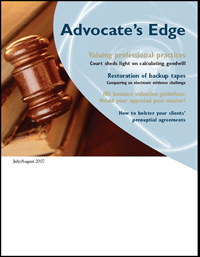 JUL/AUG 2007 Issue of Advocate’s Edge
JUL/AUG 2007 Issue of Advocate’s Edge
Valuing professional practices
Court sheds light on calculating goodwill
Recently, a California appellate court reviewed a trial court’s valuation of the goodwill in a plastic surgeon’s practice for a marital dissolution case. The opinion in In re Marriage of Ackerman (Cal. App. 2006) may be important because it suggests courts’ preferred approach for determining reasonable compensation when quantifying goodwill. This article discusses what the court considered in reaching its decision and why it highlights the need to retain qualified financial experts when dealing with reasonable compensation and goodwill.
Restoration of backup tapes
Conquering an electronic evidence challenge
Issues related to electronic evidence are mounting in all types of litigation, as evidenced by the 2006 amendments to the Federal Rules of Civil Procedure. One area drawing increased attention is the restoration of backup tapes with electronic data. Restoration often spirals into an expensive, burdensome process. A qualified forensic expert, however, can bring considerable relief by tracking down and restoring backup tapes, and helping companies to develop backup tape policies.
IRS business valuation guidelines: Would your appraisal pass muster?
The latest IRS business valuation guidelines are intended to provide standards for the agency’s personnel. In many ways, the guidelines mirror the standards established by appraisal organizations such as the American Society of Appraisers. But they also include new sections that address workpapers and the review of third-party valuations — information that could prove valuable for those concerned about how the IRS values companies or reviews outside valuation reports. This article lists the information now considered necessary for IRS valuators to develop a valuation conclusion along with other items included in the new guidelines.
How to bolster your clients’ prenuptial agreements
This short article explains, how, with the input of a CPA, prenuptial agreements can affirmatively define spouses’ financial rights, duties and obligations. Properly drafted, they can reduce stress and disagreements for spouses — before, during and after a marriage.
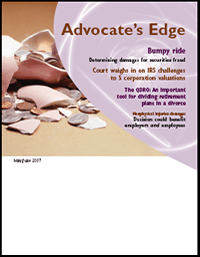 MAY/JUN 2007 Issue of Advocate’s Edge
MAY/JUN 2007 Issue of Advocate’s Edge
Bumpy ride
Determining damages for securities fraud
Calculating damages in class-action securities fraud cases is challenging. Experts engaged for such cases confront several complicated issues, including aggregate damages and determining an accurate damages amount. This article discusses the theories of recovery asserted by plaintiffs and existing case law. Because no single approach is accepted for proving out-of-pocket losses, damages experts typically employ models that rely on event studies.
Court weighs in on IRS challenges to S corporation valuations
In a decision that fuels a continued debate between taxpayers and the IRS, the U.S. Tax Court in Dallas v. Commissioner (T.C. Memo 2006) determined that an S corporation shouldn’t be tax-affected. This article summarizes the court’s finding, including its reasoning that the proportion of earnings distributed to shareholders was independent of the decision to tax-affect the stock. The court also considered several other important issues.
The QDRO: An important tool for dividing retirement plans in a divorce
If a division of marital property isn’t planned carefully, divorcing spouses can be subject to accelerated taxes and early withdrawal penalties. As this article suggests, a qualified domestic relations order (QDRO) can direct the division of a retirement plan — helping ensure that the participant’s ownership of the benefits is protected and that the nonparticipant receives the benefits to which he or she is entitled. And a QDRO allows both spouses to continue to enjoy the benefits of tax-deferred growth and avoid any early withdrawal penalty.
Nonphysical injuries damages
Decision could benefit employers and employees
In a surprising decision, a federal appellate court last year in Murphy v. IRS (D.C. Cir. 2006) found it unconstitutional for the government to tax damages for emotional distress, loss of reputation and other nonphysical personal injuries. This short article discusses why, if reinstated this spring, the decision could benefit employers as well as employees.
 MAR/APR 2007 Issue of Advocate’s Edge
MAR/APR 2007 Issue of Advocate’s Edge
Dealing with Daubert
Recent challenges to financial expert testimony
Although Daubert v. Merrell Dow Pharmaceuticals focused on the admissibility of scientific expert testimony, its progeny have had a great impact on financial expert testimony. This article reviews Rule 702 of the Federal Rules of Evidence and recent case law. By knowing the opinions in cases where financial testimony has been challenged, attorneys can better anticipate how courts will approach the admissibility question.
Cut to the chase
Joint business valuations can reduce costs and time
Because they can cut costs and time, jointly retained valuations in disputes involving a business have grown dramatically in recent years. But joint valuations can pay off only if both parties follow certain guidelines — particularly in divorce cases, where a company’s value can be among the most contentious issues. This article explains how to retain a joint appraiser, set ground rules and proceed through the appraisal process.
New businesses: Building the case for lost profits
Courts recognize that a plaintiff shouldn’t be precluded from recovering lost profits where the defendant’s actions have prevented the plaintiff from establishing a track record. But the methods typically employed to calculate lost profits damages may prove tricky when the case involves a new or unestablished business. This article talks about the methods typically employed to calculate lost profits in those situations, including relying on company projections for future revenues or applying industry growth rate projections.
How contingencies affect business value
This short article talks about the role of contingencies when assessing risk. It defines contingencies as possible uncertain gains or possible losses yet to occur or be resolved. The existence of contingencies can require adjustments to the business’s value.
 JAN/FEB 2007 Issue of Advocate’s Edge
JAN/FEB 2007 Issue of Advocate’s Edge
Fraud is afoot
ACFE report tracks the most common and costly schemes
The 2006 Association of Certified Fraud Examiners’ (ACFE’s) Report to the Nation on Occupational Fraud & Abuse estimates that U.S. businesses lose 5% of their annual revenues to fraud. This article highlights the report’s findings, including listing the most common types of asset misappropriation, corruption schemes and financial statement frauds. The ACFE report offers valuable lessons on how employees commit fraud, which can help facilitate its detection and protect businesses from future losses.
Trade secret damages
Putting a price on proprietary information
Because proprietary manufacturing, marketing and other business methods play pivotal roles in gaining and maintaining competitive advantage, businesses can’t afford to take a passive approach to trade secret misappropriation. This article explains how the Uniform Trade Secrets Act defines a trade secret and how experts calculate damages. It also discusses how the court ruled in recent trade secrets case Carbo Ceramics, Inc. v. Keefe.
Court addresses the fair pricing of private businesses
A recent decision from the State of Delaware, Delaware Open MRI Radiology Assocs., P.A. v. Kessler, provides a comprehensive overview of the fair pricing of closely held businesses. This article outlines the facts of the case, the three key issues — reading fees, expansion plans and treatment as an S corporation — considered by the court, and the ultimate ruling that the merger in the case was unfair.
Choosing the right guideline companies is critical
When valuing businesses, valuation experts often rely on the guideline company method, which entails deriving market multiples from the market prices of companies that are engaged in the same or similar lines of business as the subject company. With this approach, the selection of guideline companies is critical to avoiding overvaluations. Choosing adequate guideline companies also helps prevent judicial dismissal of expert valuations. This article lists the factors valuation experts often consider when selecting guideline companies.
This publication is distributed with the understanding that the author, publisher and distributor are not rendering legal, accounting or other professional advice or opinions on specific facts or matters, and, accordingly, assume no liability whatsoever in connection with its use.
GFAS Advocate's Edge Archives
Expert Forensic Accounting Services
Chicago | Las Vegas
FORENSIC ACCOUNTING
SERVICES
Insurance Claims
Accounting Investigations
Mergers & Acquisitions
Due Diligence Reviews
Dispute Advisory Services
Special Examinations
Contract Audits and Recoveries
LITIGATION SERVICES
Expert Witness Testimony
Commercial Damages
Shareholder/Partner Disputes
Bankruptcy and Insolvency
CPA Malpractice Claims
Contract Disputes
Estate and Trust Disputes
Data Mining & Electronic Discovery
FRAUD EXAMINATIONS







